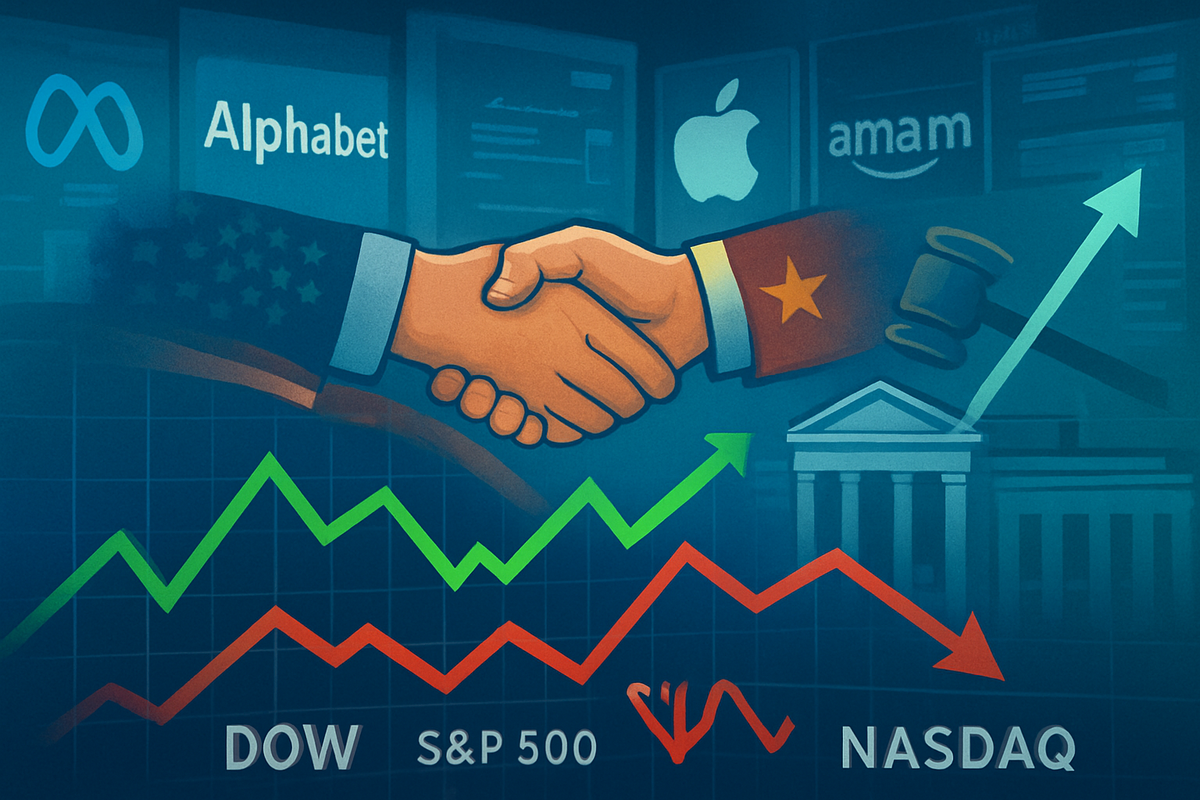
The financial markets today, October 30, 2025, present a complex tapestry of optimism and caution. While the Dow Jones Industrial Average (DJIA) managed a respectable 350-point gain, the broader S&P 500 and tech-heavy Nasdaq Composite found themselves in negative territory. This divergence underscores a market grappling with conflicting signals: a freshly minted U.S.-China trade truce offers a ray of hope for global commerce, yet the Federal Reserve's cautious stance on future interest rate cuts and mixed earnings reports from tech titans like Meta, Alphabet, Apple, and Amazon are injecting a dose of reality. Investors are clearly in a period of re-evaluation, balancing geopolitical de-escalation against monetary policy tightening and the burgeoning costs of the AI revolution.
This immediate market reaction suggests a nuanced interpretation of recent developments. The Dow's resilience, often seen as a barometer for "old economy" and value stocks, could signal a flight to perceived safety or sectors less sensitive to interest rate fluctuations. Conversely, the decline in the S&P 500 and Nasdaq points to continued pressure on growth-oriented companies, particularly those in technology, whose valuations are more susceptible to higher discount rates and increased borrowing costs. The market is not simply reacting to headlines; it is meticulously dissecting the long-term implications of these intertwined forces.
A Closer Look: Trade Truce, Fed's Stance, and Tech Earnings
Today's market movements are a direct consequence of several significant developments. Firstly, a pivotal U.S.-China trade truce, announced on October 30, 2025, at the APEC Summit, has provided a much-needed de-escalation of trade tensions. The agreement includes a U.S. commitment to reduce tariffs on Chinese imports from 57% to 47%, with fentanyl-related tariffs specifically halved from 20% to 10%. In return, China has pledged to address fentanyl precursor chemicals and resume substantial purchases of U.S. agricultural products, notably soybeans. Beijing also agreed to delay its rare earth export curbs for a year, a critical move for global technology supply chains. While offering immediate relief and a tactical pause, analysts widely view this as a temporary cease-fire rather than a comprehensive resolution, with underlying strategic competition persisting.
Secondly, the Federal Reserve's monetary policy has taken a cautious turn. On October 29, 2025, the Fed implemented its second consecutive interest rate cut, lowering the benchmark federal funds rate by 25 basis points to a target range of 3.75%-4.00%. This followed a similar cut in September, bringing borrowing costs to their lowest since 2022. However, Fed Chair Jerome Powell adopted a notably hawkish tone, stating that a December rate cut is "not a foregone conclusion." This caution stems from increasing downside risks to employment and lingering inflation concerns (CPI at 3% in September 2025), further complicated by a U.S. government shutdown that has limited access to comprehensive economic data. The Fed's decision to conclude quantitative tightening (QT) in December also signals a shift in its balance sheet strategy.
Finally, the Q3 2025 earnings season for major technology companies has been a focal point. Alphabet (NASDAQ: GOOGL) delivered stellar results, with consolidated revenue soaring 16% year-over-year to $102.3 billion, marking its first-ever $100 billion quarter. This success was driven by robust ad sales and exceptional growth in Google Cloud, fueled by surging AI demand. In contrast, Meta Platforms (NASDAQ: META), despite a 26% year-over-year revenue increase to $51.2 billion, saw its net income plunge 83% due to a significant one-time, non-cash U.S. income tax charge of $15.93 billion. Meta also forecasted "notably larger" capital expenditures for AI infrastructure in 2026, raising investor concerns about profitability. Apple (NASDAQ: AAPL) is anticipated to report strong fiscal Q4 2025 earnings later today, riding high on robust iPhone 17 sales and services growth, with its stock hitting a new high of $271.81. Amazon (NASDAQ: AMZN) is also scheduled to report today, with analysts expecting strong AWS re-acceleration and continued advertising growth, though its stock remains below all-time highs due to ongoing high capital expenditures.
Winners and Losers: Corporate Fortunes in Flux
The confluence of these events creates a dynamic environment where some companies are poised to gain, while others face significant headwinds. The U.S.-China trade truce is a clear win for companies with extensive manufacturing operations in China or those heavily reliant on exports to the Chinese market. Apple (NASDAQ: AAPL), with its vast supply chain rooted in China, stands to benefit significantly from reduced tariff uncertainty and potentially billions in savings from halved tariffs on electronics imports. This stabilization could further boost its already strong stock performance, driven by global demand for the iPhone 17. Similarly, U.S. agricultural giants like Archer-Daniels-Midland Company (NYSE: ADM) and Bunge Limited (NYSE: BG) are direct beneficiaries of China's commitment to resume large-scale purchases of U.S. soybeans and other agricultural products, stabilizing commodity prices and boosting export volumes. General consumer goods importers could also see increased demand due to lower costs.
Conversely, some companies are feeling the pinch. American rare-earth companies, such as MP Materials (NYSE: MP), which had seen their stock prices surge on expectations of increased domestic demand due to potential Chinese export curbs, have experienced sharp declines. China's decision to delay its rare earth export restrictions for a year dampens the immediate urgency for alternative supply chains, impacting their speculative valuations. Companies that "reshored" or diversified away from China during peak trade tensions might also find their competitive advantage diminishing if rivals can more easily resume China-centric operations due to tariff reductions.
The Federal Reserve's "higher for longer" stance on interest rates, even with recent cuts, creates a challenging environment for highly leveraged companies and growth stocks. Businesses with substantial debt face higher interest expenses, eroding profitability. While the recent rate cuts offer some relief, growth-oriented technology companies, whose valuations often hinge on future earnings, are still pressured by higher discount rates. This explains the broader market's shift away from speculative tech towards more established value stocks. However, banks and financial institutions, along with companies boasting strong balance sheets and low debt, tend to fare better in such an environment.
The big tech earnings reports further illustrate this divergence. Alphabet (NASDAQ: GOOGL) is a clear winner, demonstrating its ability to translate massive AI investments into tangible revenue growth, particularly in Google Cloud and advertising. This has reassured investors, leading to a significant rally in its stock. Apple (NASDAQ: AAPL) also continues its strong performance, driven by product innovation and a robust services segment. However, Meta Platforms (NASDAQ: META) faced investor skepticism, with its stock falling despite strong revenue growth, due to a substantial one-time tax charge and concerns about the escalating capital expenditures required for its AI and metaverse ambitions. Amazon (NASDAQ: AMZN) is also under scrutiny regarding its high capital expenditures, with investors eager to see how its AI investments will translate into future profitability, especially within AWS.
Wider Significance: Reshaping Industry Trends and Policy
These developments are not isolated incidents; they are integral parts of broader industry trends, with significant ripple effects across the global economy. The U.S.-China trade truce, while a temporary de-escalation, underscores a persistent trend of strategic competition between the two economic superpowers. This "new normal" of managed rivalry means companies will continue to prioritize supply chain resilience and diversification, even during periods of détente. The delay in China's rare earth export curbs offers a critical one-year window for industries reliant on these minerals to further de-risk their supply chains, potentially fostering new partnerships and investments in alternative sourcing. This sustained focus on supply chain security will likely reshape global manufacturing and trade flows for years to come.
The Federal Reserve's cautious easing, marked by two rate cuts in late 2025, signals a delicate balancing act. While lower interest rates typically boost growth stocks and stimulate borrowing, Chair Powell's "hawkish tone" suggests that the Fed is not prepared for an aggressive easing cycle. This implies a market that will increasingly demand fundamental strength and profitability, rather than relying solely on cheap capital to fuel valuations. For the technology sector, this means a continued emphasis on efficient capital allocation and a clear path to monetizing massive AI investments. The high concentration of market capitalization in a few mega-cap tech companies means that monetary policy shifts have a magnified impact on the overall market, reinforcing the need for investors to scrutinize the fundamentals of these dominant players.
The big tech earnings underscore an industry in the throes of an unprecedented AI investment boom. Companies are pouring hundreds of billions into AI infrastructure, data centers, and research, betting on AI as the next major growth driver. This creates both opportunities and challenges. On one hand, it fuels robust growth in cloud computing and digital advertising, benefiting companies like Alphabet. On the other hand, the immense capital expenditures, as highlighted by Meta's earnings, are leading to increased investor scrutiny on profitability and return on investment. This AI frenzy also has regulatory implications, with governments globally grappling with how to regulate this rapidly evolving technology, addressing concerns around data privacy, algorithmic bias, and antitrust issues. The EU's proactive stance with regulations like the Digital Services Act (DSA) and the AI Act exemplifies this global push for greater oversight, which could impact how tech giants operate and innovate. Historically, periods of transformative technological change, like the industrial revolution or the dot-com boom, have seen similar waves of intense investment, rapid innovation, and subsequent regulatory adjustments.
What Comes Next: Navigating a Shifting Landscape
The coming months and years will be defined by how these intertwined forces — U.S.-China relations, Federal Reserve policy, and the AI revolution – continue to unfold. In the short term, the U.S.-China trade truce offers a period of relative calm, allowing businesses to reassess their strategies and solidify supply chain resilience. However, the underlying strategic competition remains, meaning companies should use this window to diversify sourcing and manufacturing locations, preparing for potential future shifts in trade policy. For U.S. agriculture, renewed Chinese purchases are expected to provide immediate relief and price stability.
The Federal Reserve's cautious easing cycle is likely to continue into 2026, with further gradual rate cuts anticipated. This should lead to lower borrowing costs for consumers and businesses, potentially stimulating economic growth and supporting corporate earnings. However, investors should not expect a return to aggressively accommodative monetary policy, meaning a greater emphasis will be placed on corporate fundamentals and less on cheap capital driving market gains. This environment could favor sectors sensitive to interest rates, such as real estate and financials, while also providing opportunities for companies to refinance debt at lower costs.
For the big tech companies, the long-term outlook hinges on their ability to effectively monetize their massive AI investments. The "capex supercycle" in AI infrastructure is foundational, creating a competitive moat for early and aggressive investors. However, investor scrutiny will intensify, demanding clear pathways to profitability rather than just increased spending. This could lead to strategic pivots where companies focus on integrating AI into core services to drive revenue growth, enhance operational efficiency, or create new, profitable products. The ongoing regulatory scrutiny, particularly in antitrust and AI governance, will also necessitate strategic adaptations, potentially leading to new business models or increased compliance costs.
Possible scenarios include a "soft landing with managed tensions," where gradual Fed cuts and a stable (though not fully resolved) U.S.-China truce lead to sustained market growth, albeit with increased volatility and regulatory oversight. Alternatively, a "renewed trade war and economic slowdown" could emerge if the truce unravels, leading to renewed tariffs and a more cautious Fed, potentially triggering a recession. A third scenario, an "AI-driven boom and regulatory clash," envisions massive AI breakthroughs driving a sustained market rally, but simultaneously intensifying regulatory pressure that could lead to significant fines or operational restructuring for tech giants.
Wrap-Up: A Market in Transition
In summary, the stock market on October 30, 2025, is in a state of significant transition, characterized by a fragile optimism. The U.S.-China trade truce provides a welcome, if temporary, de-escalation of geopolitical risk, offering a measure of predictability for global commerce. However, the Federal Reserve's cautious stance on interest rate cuts, while aiming to support the economy, signals that the era of ultra-cheap money is firmly behind us. Simultaneously, the mixed earnings reports from big tech underscore a crucial shift: investors are now demanding demonstrable profitability and efficient capital allocation from the massive investments in AI, rather than simply growth at any cost.
Moving forward, the market trajectory is expected to be one of moderation and increased volatility in the near term, transitioning to a projected robust rebound in 2026, fueled by continued Fed easing and accelerating corporate earnings. However, the "thin" market breadth, where a few mega-cap tech companies disproportionately drive returns, remains a concern, raising questions about potential overvaluation.
The lasting impact of these events will be a financial landscape where geopolitical risks are an intrinsic part of economic forecasts, monetary policy remains data-dependent and cautious, and the AI revolution fundamentally reshapes industries, demanding both innovation and responsible governance.
What investors should watch for in coming months:
- Durability of the U.S.-China Trade Truce: Monitor for any signs of renewed tensions or deviations from the agreed-upon terms, which could quickly impact market sentiment and global supply chains.
- Federal Reserve's Next Moves: Closely follow upcoming FOMC meetings and Chair Powell's statements for further guidance on interest rate policy, particularly the likelihood of a December rate cut and the pace of future easing. The resolution of the U.S. government shutdown will also be key for comprehensive economic data.
- Big Tech's AI Monetization: Scrutinize future earnings reports from Meta, Alphabet, Apple, and Amazon for clear evidence of how their substantial AI investments are translating into profitable revenue growth and improved margins.
- Broader Market Breadth: Observe whether the market rally broadens beyond a handful of mega-cap tech stocks, which would indicate a healthier, more sustainable upward trend.
- Global Economic Indicators: Pay attention to inflation trends, employment data, consumer spending, and business investment globally, as these will influence central bank policies and corporate performance.
- Regulatory Developments: Keep an eye on new regulations, particularly in Europe and the U.S., concerning AI, data privacy, and antitrust, as these could impact the operational models and profitability of major tech companies.
This content is intended for informational purposes only and is not financial advice





